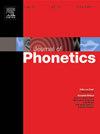Nonlinear second-order dynamics describe labial constriction trajectories across languages and contexts
IF 2.4
1区 文学
0 LANGUAGE & LINGUISTICS
引用次数: 0
Abstract
We investigate the dynamics of labial constriction trajectories during the production of /b/ and /m/ in English and Mandarin in two prosodic contexts. We find that, across languages and contexts, the ratio of instantaneous displacement to instantaneous velocity generally follows an exponential decay curve from movement onset to movement offset. We formalize this empirical discovery in a differential equation and, in combination with an assumption of point attractor dynamics, derive a nonlinear second-order dynamical system describing labial constriction trajectories. The equation has only two parameters, and . corresponds to the target state and corresponds to movement rapidity. Thus, each of the parameters corresponds to a phonetically relevant dimension of control. Nonlinear regression demonstrates that the model provides excellent fits to individual movement trajectories. Moreover, trajectories simulated from the model qualitatively match empirical trajectories, and capture key kinematic variables like duration and peak velocity. The model constitutes a proposal for the dynamics of individual articulatory movements, and thus offers a novel foundation from which to understand additional influences on articulatory kinematics like prosody, inter-movement coordination, and stochastic noise.
非线性二阶动力学描述了跨语言和上下文的唇部收缩轨迹
我们研究了英语和普通话在两种韵律语境中发/b/和/m/时唇部收缩轨迹的动态变化。我们发现,跨语言和上下文,瞬时位移与瞬时速度的比率通常遵循从运动开始到运动偏移的指数衰减曲线。我们在微分方程中形式化了这一经验发现,并结合点吸引子动力学的假设,导出了描述唇收缩轨迹的非线性二阶动力系统。方程只有T和r两个参数,T对应目标状态,r对应运动速度。因此,每个参数对应于语音相关的控制维度。非线性回归表明,该模型能很好地拟合个体运动轨迹。此外,从模型模拟的轨迹定性地匹配经验轨迹,并捕获关键的运动学变量,如持续时间和峰值速度。该模型为个体发音运动的动力学提出了建议,从而为理解韵律、运动间协调和随机噪声等对发音运动学的额外影响提供了新的基础。
本文章由计算机程序翻译,如有差异,请以英文原文为准。
求助全文
约1分钟内获得全文
求助全文
来源期刊

Journal of Phonetics
Multiple-
CiteScore
3.50
自引率
26.30%
发文量
49
期刊介绍:
The Journal of Phonetics publishes papers of an experimental or theoretical nature that deal with phonetic aspects of language and linguistic communication processes. Papers dealing with technological and/or pathological topics, or papers of an interdisciplinary nature are also suitable, provided that linguistic-phonetic principles underlie the work reported. Regular articles, review articles, and letters to the editor are published. Themed issues are also published, devoted entirely to a specific subject of interest within the field of phonetics.
 求助内容:
求助内容: 应助结果提醒方式:
应助结果提醒方式:


